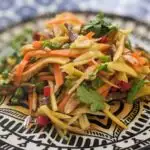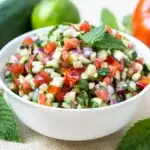Pasembur is a Malaysian salad of vegetables with protein in a warm sweet potato and peanut sauce. It is also known as rojak.
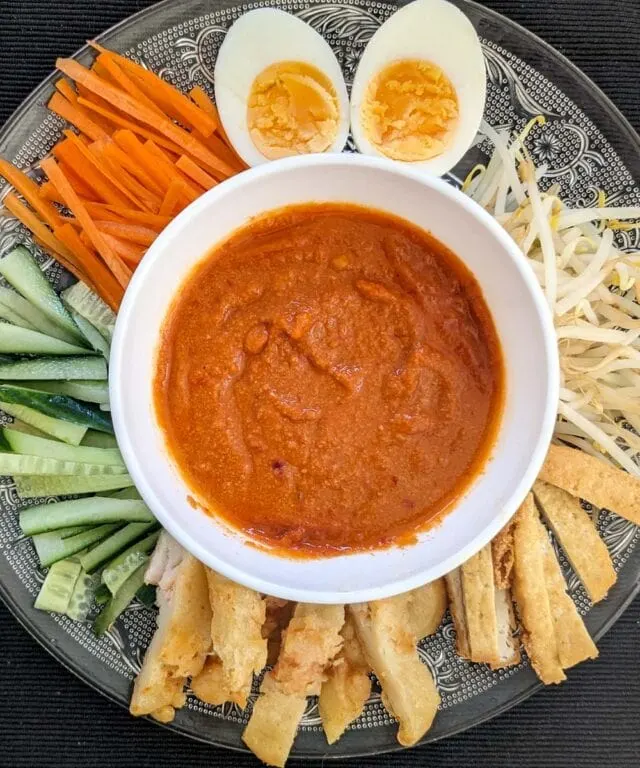
What is a salad?
According to the Oxford Dictionary, a salad is “a cold dish of various mixtures of raw or cooked vegetables, usually seasoned with oil, vinegar, or other dressing and sometimes accompanied by meat, fish, or other ingredients.”
Relying on that definition, if one wishes to make a salad – the options are endless. And indeed, as we look at different cuisines from around the globe, we see that many of them, if not all, would include at least one dish that could be called a “salad”.
And yet, this food category is Western in origin.
During my travels around the world, I’ve encountered numerous dishes that I first regarded as “salads”. However, once I became more familiar with the local culinary culture – I learned otherwise.
Salad around the world
Now, when traveling the world, I try to keep in mind two important things:
First of all, locals perceive such non-Western “salad” dishes in a completely different way. This difference in perception might influence the dish’s function in the local dining culture.
Som tam, for instance, is a Thai Lao dish that may be roughly translated to “papaya salad”. Yet, on many occasions, som tam is eaten with sticky rice as a main dish.
Secondly, due to the more recent influence of Western culture, some non-Western cuisines would define certain dishes as “salads”. But, those dishes might not align with the classic Western definition.
Such dishes may be served hot, completely cooked, or even fall into a different Western food category (many Middle Eastern “salads” may fall under the Western category of dips or condiments).
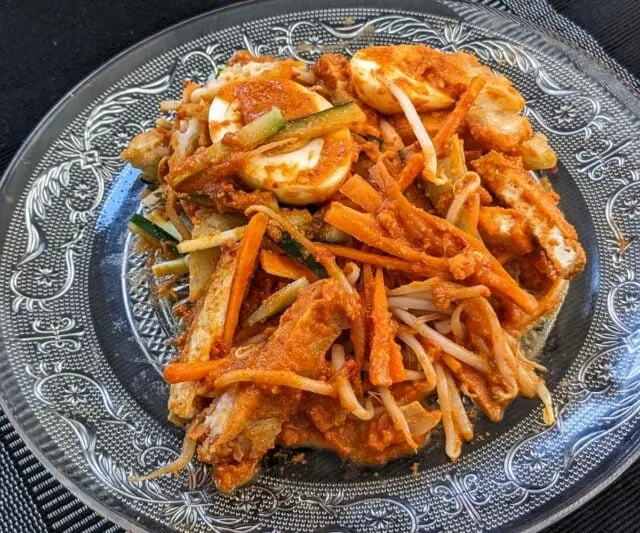
The story of pasembur – A Malaysian salad
Pasembur is clearly one of those exceptions.
The dish was born within the Indian Muslim community of Malaysia, where (male) cooks are addressed as “Mamak”, and therefore their cuisine is called “mamak food”.
On my last trip to Langkawi, a beautiful island in Northern Malaysia, I was introduced to their unique cuisine, which combines South Indian, Middle Eastern, and Malay flavors and cooking methods.
Pasembur is also known as “Indian rojak”. Rojak is a food category of itself in Malaysian and Indonesian cuisine, of Javanese origin. Due to some similarities in ingredients, Pasembur sometimes falls into that food category as well!
If we disregard the raw vegetable (shredded cucumber and bean sprouts) component of the dish, which doesn’t even make up 50% of it, we learn that Pasembur is a warm dish, made primarily with cooked ingredients.
A salad indeed?
Ingredients for pasembur (Indian rojak)
Simply put, Pasembur is a Malaysian salad.
Pasembur may vary from one restaurant to another, but it typically consists of a protein source such as fried tofu, shrimp fritters, and/or a boiled egg. This combines with root vegetables (like jicama, turnip, or carrot), shredded cucumber, and bean sprouts.
It is dressed with a hot, creamy, and luscious sauce, made from sweet potato, peanuts, tamarind, and other seasonings.
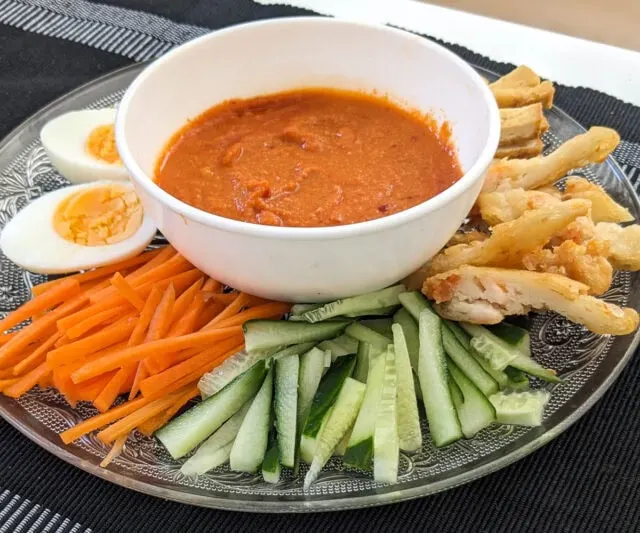
How to make pasembur
There are a few components to making pasembur.
- The sauce – The sauce (or dressing) for this salad is made up of cooked sweet potatoes, chilies, peanuts, and tamarind blended to a saucy consistency.
- The shrimp fritters – The fritters feature small shrimp in a wheat and rice flour batter. They are shallow fried and then sliced into strips for the salad.
- The tofu and eggs – The tofu needs to be fried and cut into strips. The eggs need to be hard-boiled.
- Assembly – This salad is about presentation. It can be assembled on individual plates or a larger serving platter. The sauce is placed in a bowl in the center of the plate, and the salad ingredients are arranged around the sauce.
- Eating – When ready to eat, the warm sauce is poured over the salad ingredients and mixed together.
Can I prepare pasembur ahead of time?
Some of the ingredients can be prepared in advance, such as the dressing, the root vegetable (if it needs to be boiled to soften to a desired texture), and the hard-boiled egg.
However, I strongly recommend frying the tofu and fritters, as well as preparing the raw vegetables just before serving.
You may also heat the dressing a bit if needed. This will ensure a wide range of texture, temperature, and flavor – all in one dish!
How to serve pasembur
As you might imagine, this dish can be quite heavy, especially compared to a Mediterranean lettuce salad or a Thai Som Tam.
It is often served as a main dish, and let me tell you – you won’t leave the table hungry.

As globalization takes place and the word “salad” finds its way to cuisines around the world, sometimes resemblance may win over the differences.
Pasembur may be cooked and served warm, yet it is still a dish of mixed ingredients, seasoned with a dressing. And who am I to decide for the wise Mamak chefs how to define their magnificent creations?
Pasembur (Malaysian Indian Rojak Salad)

Pasembur is a Malaysian salad of vegetables with protein in a warm sweet potato and peanut sauce. It is also known as rojak.
Ingredients
For the sauce
- 1/4 lb (100 g) sweet potatoes
- 5 dried chilies, seeds removed (choose your chilies based on your desired heat)
- 1/4 cup peanuts
- 2 Tbsp palm sugar (or brown sugar)
- 1 Tbsp tamarind concentrate
- 1 tsp dried shrimp (optional)
- 1 cup water (or more, if needed)
- Salt, to taste
For the shrimp fritters
- 1/2 c (50 g) all-purpose flour
- 1/3 c (50 g) rice flour
- 1/2 tsp salt
- 1/2 tsp sugar
- 1 Tbsp oil
- 1/2 cup water
- 2 Tbsp (50 g) small shrimp (shelled and cooked)
- 1/2 c oil, for frying
Putting it all together
- 3 medium cucumber, julienned
- 3 jicama, julienned* (boil if desired for texture)
- 1 1/2 cup bean sprouts, blanched
- 2 hard-boiled egg, halved
- 5 oz (150 g) tofu, deep fried and cut into strips
- 3 shrimp fritters, cut into strips
Instructions
For the sauce
- In a medium pot, boil enough water to cover your sweet potatoes. Cook the sweet potatoes whole for 15 minutes, or until you can stab the potato easily with a fork.
- While the potato is cooking, in a separate bowl, soak the dried chilis in hot water for 15 minutes.
- Once cooked, peel the sweet potato. Place the potato, soaked chilies, and remaining sauce ingredients in a blender or a food processor. Blend until combined. (I like to keep it relatively thick and chunky, but if a thinner and more homogenous consistency is desired, add more water and blend again.)
- Add salt to taste, blend again, and set aside.
- Mix the all-purpose flour, rice flour, salt, and sugar in a bowl.
- Gradually add the oil and water while mixing consistently, until a batter forms.
- Mix the small shrimp into the batter.
- Heat ½ cup oil in a frying pan.
- Using a ladle, pour small amounts of batter into the oil (about 3 inches / 7 cm in diameter). Shallow fry the fritters, flipping once, until the fritters are crispy on both sides.
- Drain the fritters from excess oil and set aside on a paper towel-lined plate.
- Repeat as needed until all the batter has been used (do not over-crowd the pan as you are frying the fritters).
- To assemble, place a small bowl with sauce in the middle of a larger serving plate. Surround the bowl with an assortment of cucumbers, jicama (or another crunchy substitute), bean sprouts, fried tofu, boiled egg, and sliced shrimp fritters.
- Before eating, pour the sauce over the assorted ingredients and mix well.
For the shrimp fritters
To assemble the salad**
Notes
*In some countries, Jicama can be difficult to find. In that case, it may be substituted with other crunchy root vegetables, like carrots or turnips.
**You can assemble this dish on one large serving platter or as individual servings. Assembly is the same for either, just the quantities you use will change.
Recommended Products
As an Amazon Associate and member of other affiliate programs, We earn from qualifying purchases.
Nutrition Information:
Yield:
3Serving Size:
1/3 of recipeAmount Per Serving: Calories: 515
If you liked this recipe, here are some similar dishes you may enjoy!




